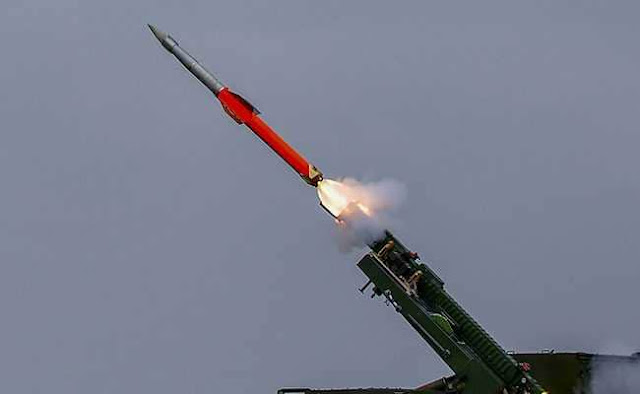India improving Missile Inventory of it’s Amred Forces
India
improving Missile Inventory of it’s Amred Forces
By:-Kartikeya Semwal
We all know that
India has 2 disturbing & distrustful international neighbours namely
Pakistan & China. We have fought wars with both in different years in the
past. And our army keeps having skirmishes on both- it’s eastern & western
fronts. India remains under threat to fight a two-front war which is a national
issue of great importance. In order to address this issue effectively, DRDO (Defence
Research & Development Organization) has been working hard to develop a
range of different types of missiles ranging from sub-sonic, super-sonic, SRBM
(Short Range Ballistic Missile), AAD (Advanced Air Defence), QRSAM (Quick Reaction
Surface to Air Missile) MRSAM (Medium Range Surface to Air Missile) & ASM (Air
to Surface Missile). This will enable the Indian Army & give them teeth to
fight a limited, quick & effective 2-front war, especially with China.  |
| QRSAM test-fired. |
Recently, DRDO successfully test-fired 2 state of
the art QRSAM 1 after another at the ITR (Integrated Test Range) in Chandipur. Both
the QRSAMs were tested against live targets and met all mission objectives by destroying
the targets completely. Both the missiles engaged their targets at different
ranges & different elevations. This missile is all-weather, all terrain
& can be stored in canister or mounted on truck. It is also equipped with
electronic counter-measure sub-systems against jamming by aircraft radars &
drones.
 |
| NAG with it's launcher NAMICA |
In 2019 summers itself, India’s SFC (Strategic
Forces Command) had also carried out a night test of Brahmos ballistic missile
at ITR Chandipur, Odisha. This is a supersonic strategic cruise missile that can
hit up to 290km in enemy territory & has been developed specifically to
deter Chinese aggression. The missile completed all it’s objectives in the
night test & can be fired from land, air & sea to destroy enemy
frontlines. Brahmos NG (Next Generation) is being used by Indian Airforce on it’s
frontline fighter Su-30MKI.
 |
| The BRAHMOS Supersonic Cruise Missle |
Last year, India had also placed an order for 5
launchers of Barak 8 missiles that will carry 200 missiles. Barak 8 is an
Indo-Israel MRSAM (Medium Range Surface to Air Missile) that has a range of 100
km. It has been developed to neutralize threat from aircrafts, helicopters,
UAVs, Drones, ballistic & cruise missiles & combat jets. Each missile
system contains a missile container, radar, tactical computers &
installation system. It has the ability to simultaneously engage multiple
targets. It’s delivery to Indian Army will start from 2020 & will be
completed by 2023. Indian Navy has also ordered this missile’s naval variant to
deploy it on it’s Frigates & Destroyers.
 |
| Barak 8 Missile System |
Another missile system tested by DRDO this year
is Akash’s new variant. Akash is an indigenous MRSAM (Medium Range Surface to
Air Missile) whose latest variant comes equipped with an indigenous seeker.
This variant was test-fired in Balasore off-coast test region in Odisha. It was
the 2nd successful test this supersonic missile that has a range of
25 km. It’s variants Mk1 & Mk2 are being used by Indian Army & India
Airforce.
 |
| Akash Air Defence System |
There is 1 more missile which was tested this year
by DRDO and that is Pralay, a conventional strike SSM (Surface to Surface Missile).
Pralay is also an exo-atmospheric interceptor missile which comes equipped with
canisters, has a range of 500 km and can carry a payload of 800kg. Pralay is a
ballistic missile that has been developed to keep Indian Airforce’s bases on
the eastern front safe. It will hopefully be given to Indian Army for
user-trials by next year, after which it will be ready for induction.
 |
| Pralay Exo-Atmospheric Interceptor Missile |
Last but not the least is the ASM (Air to Surface Missile)
being developed by DRDO, which is an NGARM (New Generation Anti-Radiation
Missile). This missile is aimed at engaging & destroying enemy radars and
communication systems that emit radio frequencies from across the border. What
makes this missile effective is an on-board passive homing head (PHH) that
helps it discriminate and lock target out of a number of emitters on the field.
It can detect radio emissions from a 100 km distance & comes equipped with
monolithic microwave integrated circuit (MMIC). Though this missile has been
developed for Su-30 MKI fighters, but it can also be integrated with Mirage
2000 & Jaguar jets.
 |
| NGARM Anti Radiation Missile |
In all, DRDO is working on developing different
types of missiles to make India’s Armed Forces efficient & capable of carrying
out strategic strikes in case of war, and turn the tide in India’s favour in a
short span of time.



Comments
Post a Comment